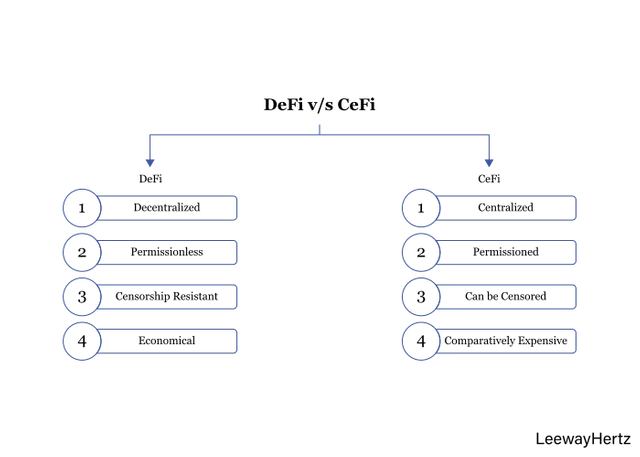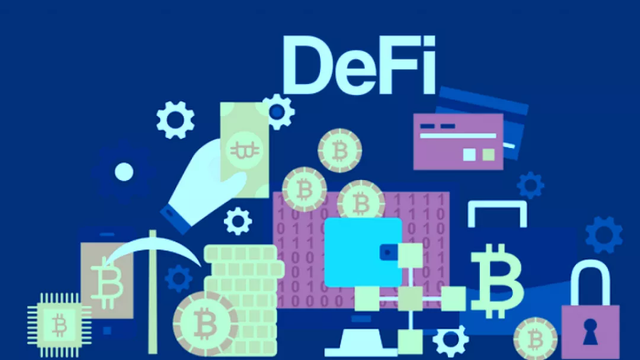The 3 system operations and 5 benefits behind DeFi's popularity
DeFi is so popular that it has become one of the hottest topics in the encryption field.
 Decentralized Finance (DeFi)
Decentralized Finance (DeFi)
With the emergence of blockchain technology, services in the financial industry have made great progress. The blockchain has injected vitality into the cryptocurrency industry, and the emergence of DeFi on top of the blockchain has brought greater empowerment to the industry. Now DeFi Pulse shows that the total locked-up volume (TVL) in the DeFi protocol has reached 26.57 billion US dollars. It is worth noting that DeFi's popularity has continued to increase worldwide. It has grown more than 20 times in one year.
De F i is so popular that it has become one of the hottest topics in the encryption field.
What is De F i?
Decentralized finance is called DeFi for short. It is a financial application ecosystem developed using blockchain technology. It operates transactions without allowing any third-party intervention. It implements a peer-to-peer network and establishes a decentralized environment where everyone can freely connect and manage their own assets. Smart contracts are self-executing and do not require intermediaries. DeFi aims to provide a transparent, open source, license-free decentralized financial environment.
What is the difference between De F i and Ce F i?
In Centralized Finance (CeFi), all transaction orders are processed by centralized exchanges. The central authority controls the funds; users do not possess any private keys to access the wallet. Both decentralized finance and centralized finance provide lending and payment services. The difference between the two is that DeFi is a decentralized platform, while CeFi is a centralized platform.

When comparing De F i and Ce F i, safety is the main concern. CeFi is fragile and prone to various risks, while DeFi provides a completely secure trading platform. DeFi uses a feature called "Proof of Work" to ensure that the system is safe and reliable.
In addition, De F i is an unlicensed network, and Ce F i is a licensed network. This means that in CeFi, some specific operations can only be performed by centrally authorized personnel, while DeFi does not have any centrally authorized personnel.
Comparing the prices of the two platforms, DeFi is cheaper because it only involves network fees, while in CeFi, multiple intermediaries charge high fees.
How does the De F i system work?
The operation of the decentralized financial system mainly relies on three parts:
Blockchain technology
Decentralized applications (DApps)
Smart contract
Decentralized applications provide a platform for executing financial transactions on the blockchain. Through smart contracts, transactions are executed between related parties without the participation of a third party. Smart contracts aim to eliminate all intermediaries involved.
The purpose of developing the DeFi platform is to provide an automated, reliable and tamper-proof system. Decentralized applications built with these characteristics automatically interact with funds in a variety of ways, without involving banks or intermediaries.
Recently, a new function has been introduced in the De F i ecosystem, namely Yield Farming or Liquidity Mining. It is a way to reward users for providing liquidity in the DApps system . It involves lending out cryptocurrency and earning interest on it, just like a traditional bank's loan system. The implementation of Yield Farming has two main goals, one is to motivate users to provide liquidity, and the other is to fairly distribute the governance token of DeFi applications to protocol users.

What are the benefits of De F i?
transparency
Since every transaction in the blockchain network will be broadcast to every node, higher transparency is achieved. Every node in the network can verify data. Such a high level of transparency provides room for rich data analysis and ensures that everyone can verify access.
Immutability
The data in the blockchain cannot be changed. Every block in the network that contains transaction details and other information uses encryption principles and hash values.
Interoperability
The blockchain ensures the seamless connection of cross-chain transactions by connecting different blockchain systems, thereby achieving interoperability.
Decentralization
The decentralized environment of the blockchain ensures the transfer of control from the central authority to the distributed network. Decentralization provides its users with the benefits of a trustless environment, improves data consistency, and reduces weaknesses.
Self-hosted
Blockchain allows its users to own their digital assets by providing access and control of private keys.
Conclusion
With the implementation of blockchain technology, De F i truly has great potential to reshape the entire global financial system. As more and more people adopt blockchain for transactions and business development, it is expected that a major shift towards decentralized governance and decision-making will soon take place.
Thanks for this article, I think that defi lending and borrowing platform development is a powerful tool to change the future of the fintech industry. This system has many advantages, the main of which are ease of service and transparency, there is complete control of funds by users (you can trade at any time and with anyone).